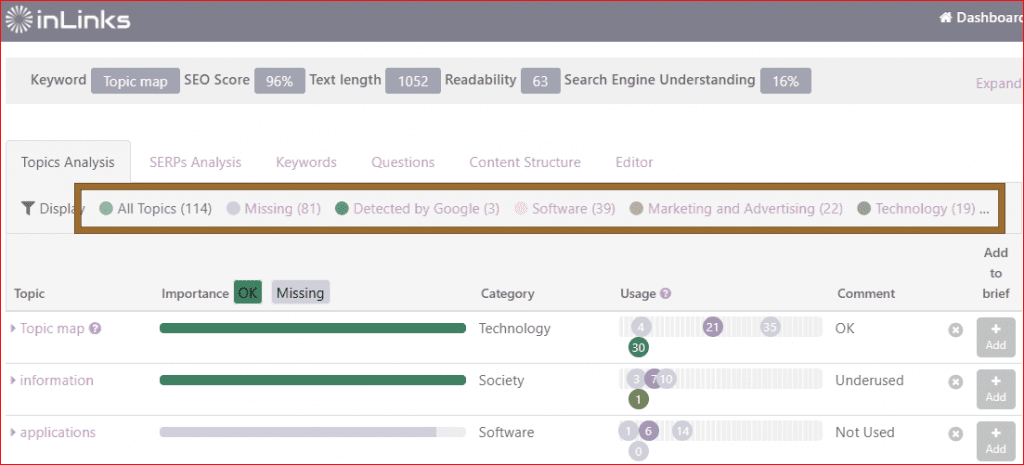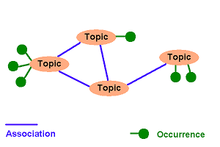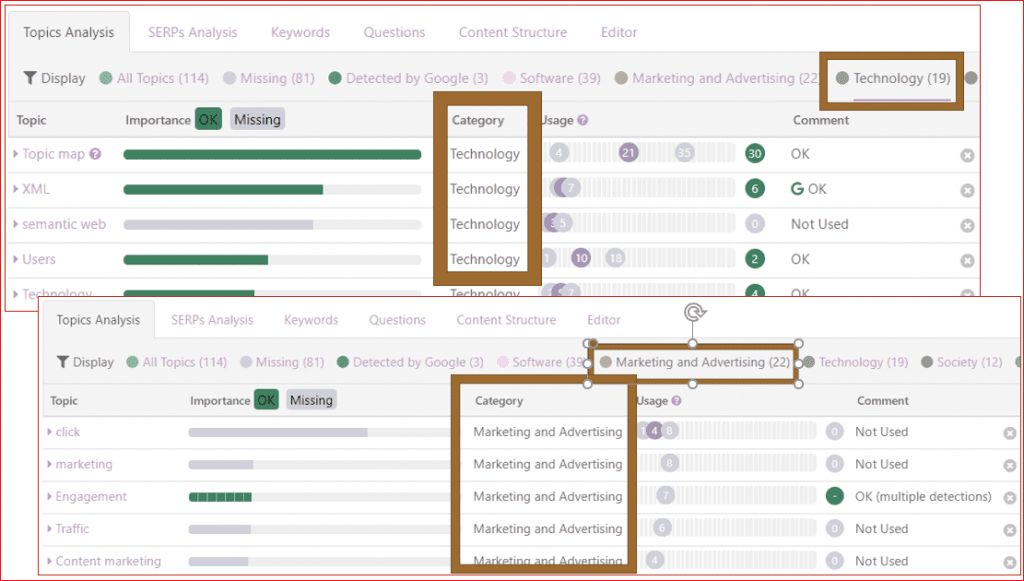Synopsis
Topic Mapping helps you to know what to write about and how to structure your content. Learning how to curate a perfect topic map should significantly improve your chances of being seen on Google in an Entity SEO and B.E.R.T. driven world.
InLinks has made a UX Improvement to make it easier for writers to see and filter topic maps into themes. Whether you use InLinks or not, understanding the idea will help you write better content.



What is a Topic Map?
It’s much like a knowledge graph and can be represented in a few different ways. In one sense it is simply a list of entities or ideas that a corpus of content uses (or intends to use, if you are creating the content from scratch), with connections showing the relationship between those topics. They even have an official ISO standard! (ISO/IEC 13250, apparently). The image above shows the new InLinks filtering of topics, which we will come on to. Wikipedia suggests they were invented in the late 1990s, but I think that’s rubbish. I came across Tony Buzan’s “Mind Maps” in the 1970s and frankly, the difference is mere semantics! Shock, horror, Wikipedia is wrong. (Maybe someone can amend Wikipedia and cite this page?)


Use our free entity checker – and explore more complimentary SEO tools from Inlinks. Topic Maps are also similar to the way InLinks portrays a website as a knowledge graph.

Automating Topic Maps
You can create a list of topics manually, by curating a bunch of authoritative sources and listing the ideas. However, automating this process does save a load of time. This is an idea that is not new. People as old as me will recall a product called Web Position Gold, which (in the premium version) would look up the result on any given search engine for a keyword, then extract the keywords on the top 10 pages and compare the wordcounts to your own content.

Keywords, however, are a crude methodology in a B.E.R.T driven world. Two reasons:
- A list of keywords does not necessarily connect synonyms and different grammatical ways of writing about an idea, so relying on keywords can start to create a monotonous copy.
- There are no relationships in this list and no hierarchy of what is important to use. The result may be that text does not connect ideas into a coherent argument.
Inlinks has taken this idea several steps forward, by automating the extraction of TOPICS from a set of pages which are already seen as important to cover for any search term. By extracting topics, instead of words, much of the problems of synonyms and grammar variations are avoided. In addition, InLinks is able to categorize topics. By understanding your own company’s verticle, you can avoid writing about topics which are found simply because the corpus of content you were analyzing has a different overall story that yours. This is important to understand. So let’s look at the one I created for this article.

This visualization proposes a way in which you might approach an article on Topic Mapping. However – the machine’s AI cannot tell what I have in mind or what kind of writer I am. If I am writing about Topic Maps from a technology perspective (which I am) then different topics are important than if I am talking about topic maps in a marketing and advertising context. Now, there may be overlap, and that is often the case, so the new UX in the InLinks tool has made filtering by category for them much easier. In this case, I can see the different entities I should be writing about in the context of technology, vs the context of marketing and advertising.

So now I can see that I might want to cover ideas like XML and the semantic web, but I might be less interested in topics like traffic and clicks. Even so, it is important to drill down into these ideas a LITTLE more, before blindly writing. In this instance, one of the pages analyzed was an excellent article from 2002 (who says old content doesn’t rank?) by a guy called Lars Marius Garshol. The article is hosted on XML.com! Maybe this unduly influenced the automated suggestion? Looking closer, I can see that XML is indeed talked about in some depth in representing topic graphs, so I now know that XML has been used by many people to create topic map representations.
InLinks, on the other hand, creates a publicly accessible URL. (The full topic map for this article is in this content brief I used to create it.)
Topic Maps and RDF
The W3C (Worldwide Web Consortium) has discussed similarities between Topic Maps and RDF (Resource Description Framework). In fact, there are pages on their Interoperability going back to 2006. The disadvantage of RDF for content writing is that RDF describes a binary relationship between two entities. A map is much closer to a human’s approach to ideas, with many often chaotic relationships. In layman terms, topic mapping describes ideas more as humans see them than machines store them. Humans tend to write in a conversational style.
Machines like to store ideas in a knowledge graph or other form of a database. The two approaches both aim to understand connections between ideas, but the conversational style of humans can flummox structured databases that don’t (yet) see all the connections that we do. I think (from a philosophical point of view) creating content using a topic map as a place to start will then help a search engine using entities to better map this multilayered way of connecting ideas and converting them into ideas that can be also connected in complex information retrieval systems (Like Google!).
There are some useful pages about Topic Mapping and RDF on the W3C site and are referenced at the end of this article.
Language changes! Maintain your content
Sources used for the topic map for this article
- Wikipedia (en.wikipedia.org)
- What Are Topic Maps (xml.com)
- How to Use Topic Maps to Run Generative User Interviews | by Hadrien Raffalli | Built to Adapt (builttoadapt.io)
- Adding Topics to a DITA Map (oxygenxml.com)
- khan-academy-accuplacer-topic-map – CCV (ccv.edu)
- Topic Maps | Contextualise – Structured Thought (contextualise.dev)
- Increase Social Media Engagement with Social Media Topic Maps (digitalmarketer.com)
- YouTube (youtube.com)
- A Distributed Topic Map Architecture for Enterprise Knowledge Management – IEEE Conference Publication (ieeexplore.ieee.org)
Other useful references:
- W3C article on Topic Maps
- Try InLinks for FREE




Leave a Reply
Want to join the discussion?Feel free to contribute!